Morning: Despite our late night the day before, we were still eager to get an early start on our day, and awoke just after dawn. Armed with a detailed map found online and printed before we left, we headed off in the direction of our first stop on the Macau World Heritage Trail, passing by several sights including the Grand Lisboa Casino and Macau Tower.
Historic Centre of Macau: Commonly referred to as the Macau World Heritage Trail, the Historic Centre of Macau is a collection of approximately twenty-five sites on the Macau Peninsula recognized by UNESCO as a World Heritage Site. All of the sites were marked on our map and signposts written in Chinese, Portuguese and English were abundant throughout the area, making it very easy to get from one site to the next.
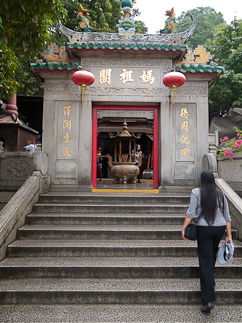
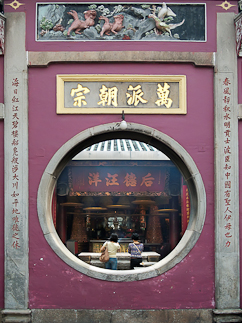
A-Ma Temple: Almost an hour after we started off on our walk, we arrived at Barra Square, the site of A-Ma Temple. A-Ma Temple predates the arrival of the Portuguese to Macau and was built to honor Matsu, the Goddess of Seafarers. It is thought that when the Portuguese first arrived, they set foot just outside the temple and, after asking the name of the place, were told the name of the temple in the local language. To the Portuguese, it sounded like "Macau", and that is what the island has been called ever since.
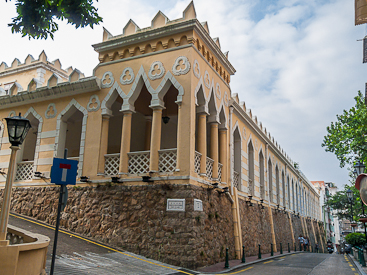

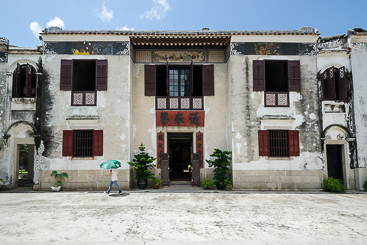
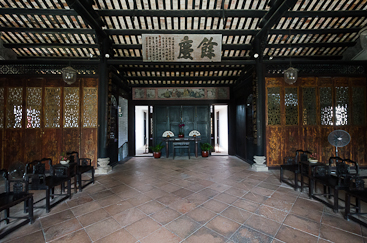
Moorish Barracks, Lilau Square, & Mandarin's House: Our second stop on the trail was at Moorish Barracks. Built in 1874 in neoclassical style with Islamic influences, it housed an Indian Army regiment used to reinforce the Macau police force. Today it is used by the Harbor Authority, so tourists are not allowed inside the building. Further up the road is Lilau Square, a small square in the first Portuguese residential district in Macau. Just across the street from the square is Mandarin's House, family home of prominent Chinese literary figure Zheng Guanying. The house is primarily traditional Chinese in design, but didn't open for tours until 10:00am, so we were unable to see inside.
We returned to Macau in June, 2013 and first attempted to see Mandarin's House on a Wednesday, but it wasn't open on Wednesdays. So, we returned the next day, when we were finally able to get inside this impressive mansion for a tour.
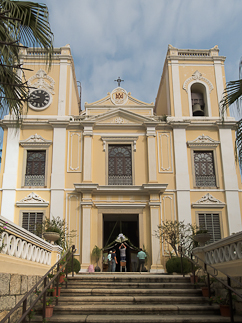
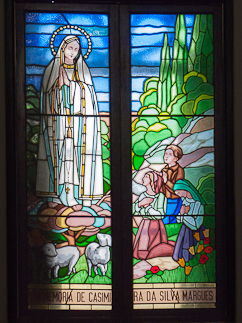
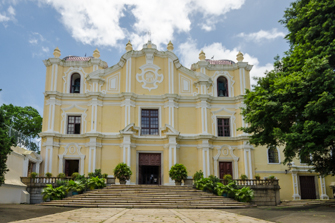
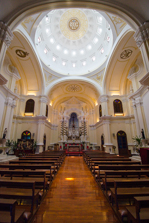
St. Lawrence's Church & St. Joseph’s Seminary and Church: Continuing north we came to St. Lawrence's Church, originally built by the Jesuits before 1560. Of note is its collection of stained glass windows depicting scenes from the bible. Families of Portuguese sailors would often gather on the steps of the church to watch for the return of their loved ones.
St. Joseph's Seminary and Church was our next stop, serving as the base for the Jesuits' missionary work in the region. However, the gates were locked, not to be opened until 10:00am, so we were unable to see inside.
On our return trip to Macau in June 2013, we again stopped by St. Joseph's Seminary and Church and were able to see inside the church. It was definitely worth taking the time to go back to see, since we were in Macau on business anyway.
St. Augustine’s Square: St. Augustine’s Square contains Dom Pedro V Theatre, St. Augustine’s Church, and Sir Robert Ho Tung Library, as well as the rear entrance to St. Joseph’s Seminary and Church. Again we ran into problems with sights being closed so we continued on until we arrived at Senado Square, just off of which we were able to find a McDonald's for brunch. It was past 10:00 by the time we finished eating so we decided to backtrack and see this last cluster of sites before continuing further along the trail.
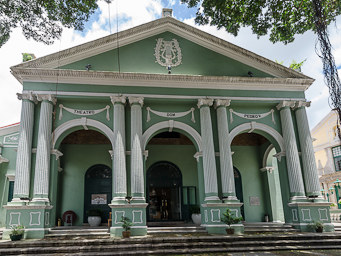
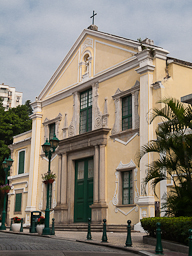
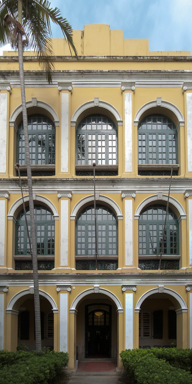
Dom Pedro V Theatre, St. Augustine’s Church, & Sir Robert Ho Tung Library: The Dom Pedro V Theater was the first western-style theater in China, having been built in 1860. Its ballroom and auditorium are still used for important public events and celebrations today. It was closed for renovation, so we were unable to go inside. St. Augustine's Church, founded by Spanish Augustinian priests in 1591, is best known for organizing the Way of the Crosses Procession, one of the most popular processions through the city. The rear entrance to St. Joseph’s Seminary and Church was still locked, so we were never able to see inside the complex. However, we were able to look inside the Sir Robert Ho Tung Library.
Sir Robert Ho Tung, a prominent Hong Kong businessman, purchased the house in 1918 as a retreat, moving there permanently during the Second World War. He donated it to the Macau government after his death in 1955, along with money for the purchase of books to convert it into a public library, which was opened in 1958. The first floor of the building contains many rare Chinese books.
The renovation work on Dom Pedro V Theatre was completed when we returned in June 2013, so we were then able to see inside.
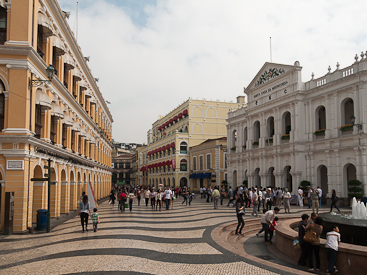
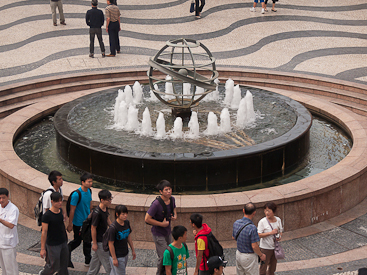
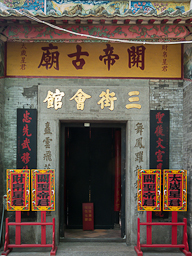
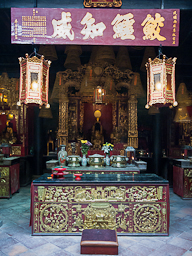
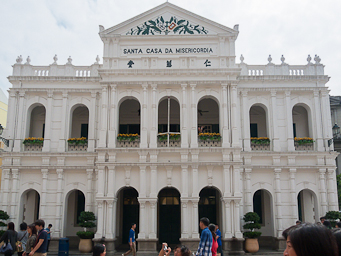
Senado Square, Sam Kai Vui Kun Temple, & Holy House of Mercy: Senado Square is the main city square and several buildings of historical note are located there. It is still a popular place for locals to shop, dine, or just hang out. The first site we located in Senado Square was Sam Kai Vui Kun Temple. Business representatives from three nearby streets held meetings in this building prior to the establishment of the Chinese Chamber of Commerce. Now it is used just for worshiping Kuan Tai, the deity of loyalty and righteousness. However, its historical use gave it its name, which literally translates to "Three Street Meeting Quarters". On the opposing side of the square from the temple sits the Holy House of Mercy. Established by the first Bishop of Macau, one of this institution's main roles was to provide support for widows and orphans of sailors lost at sea. They also founded several welfare institutions, included a hospital, a lepers clinic, and an orphanage. We paid the small admission price to visit the museum and get a second-story view of the square below.
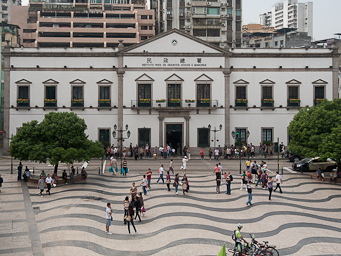
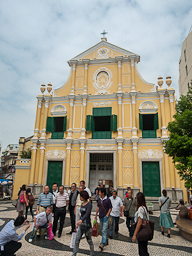
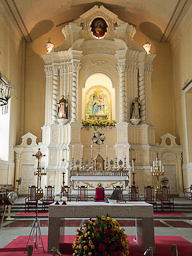
“Leal Senado” Building & St. Dominic's Church: Heading over to one end of the square, we entered the "Leal Senado" (Loyal Senate) building. It was built in 1784 as Macau's City Hall, and still serves the same function today. Because it is still used as a functioning government building, we were only able to enter the lobby, the inner courtyard, and a small art gallery located just off the lobby. At the far end of Senado Square stands St. Dominic's Church. Three Spanish Dominican priests from Acapulco, Mexico established St. Dominic's in 1587. The original building was constructed of wood, earning it the Chinese name of Pan Cheont Tong, or Church of Wooden Planks.
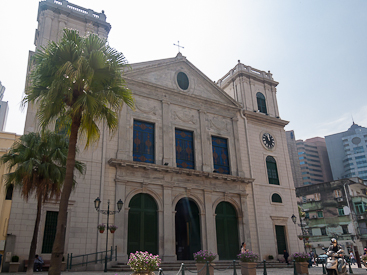
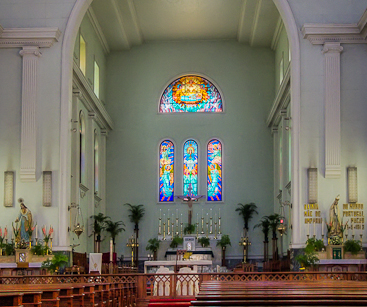
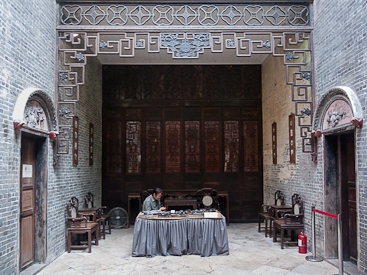
Cathedral of the Nativity of Our Lady & Lou Kau Mansion: After taking a short water break, we headed east up the hill from Senado Square until we reached the Cathedral. Originally constructed in 1622 in taipa, a clay and straw material compacted in a timber frame, the Cathedral was reconstructed in 1844. The Cathedral used to be the location of public ceremonies where the Governors of Macau would accept their official posts. Heading back down the hill, and back toward St. Dominic's, we stopped at Lou Kau Mansion. Lou Kau was a prominent banker and honored by the King of Portugal for his charitable works. His mansion is built in typical Chinese style, but western influences can be seen in some of its decorations.
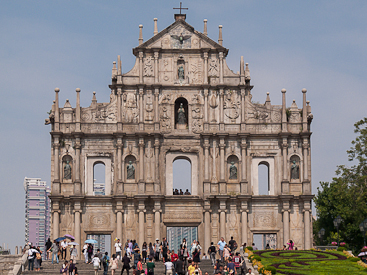
Ruins of St. Paul's: We continued along the heritage trail, passed by St. Dominic's, and headed up a narrow, very crowded street lined with upscale shops until we reached the facade of the Church of Mater Dei, also known as the Cathedral of St. Paul. This facade is unique in its mixture of Jesuit images and Chinese themes. Along with the facade, there still exists the foundations of the complex, consisting of the church and St. Paul's College, and the crypts of the Jesuits who founded and maintained it. First established in 1580, it suffered fires in 1595 and 1601, was reconstructed between 1602 and 1640, and suffered its third fire in 1835, leaving just the ruins seen today. The ruins are one of the most popular tourist sites in Macau, as evidenced by the throng of visitors and tour buses surrounding the site.
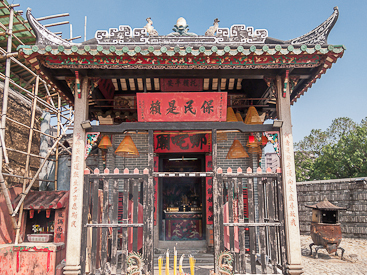
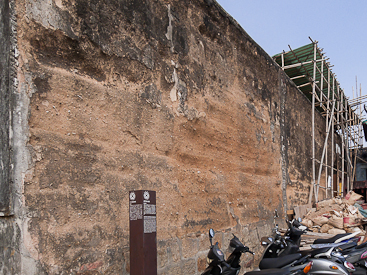
Na Tcha Temple & Section of the Old City Walls: Sitting on the eastern side of the Ruins of St. Paul's is Na Tcha Temple, a small Taoist temple dedicated to the worship of Na Tcha, a god of protection. It was built in 1888 and rebuilt in 1901, and is still in use today. Just to the east of Na Tcha Temple is a Section of the Old City Walls. Very little of the protective walls that once stood in Macau have survived. This section is 18.5m long, 5.6m high and 1m thick (60ft x 18ft x 3ft) and is made from chunambo, a mixture of sand, soil, clay, rice straws, crushed rock and oyster shells.
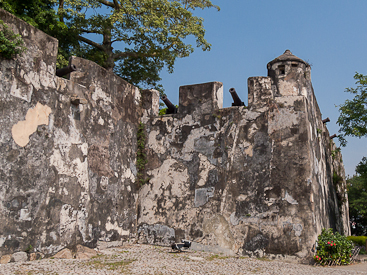
Mount Fortress: Crossing over to the western side of the Ruins of St. Paul's, we come upon Mount Fortress, another popular site for tourists. Built by the Jesuits in 1617-1626, the fortress served as the main defensive structure for Macau until it was demilitarized in 1976. Built primarily for repelling attacks from the sea, as no weapons face mainland China, the fortress was instrumental in repelling an attack by the Dutch in 1622. Once holding cannons, military barracks, wells and an arsenal, it is now the site of the Museum of Macau, constructed in 1998.
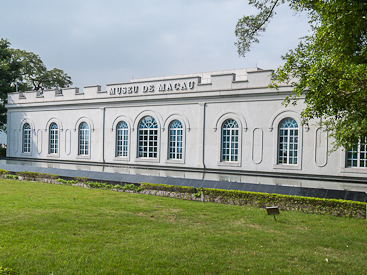
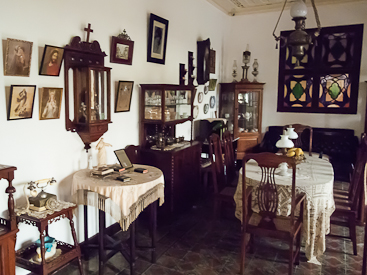
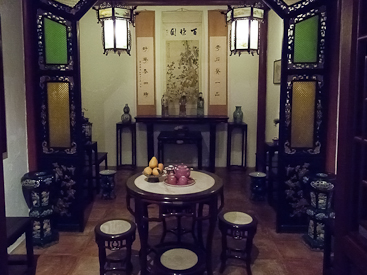
Museum of Macau: Although not technically part of the heritage trail, we decided to enter the Museum of Macau. The first floor focused on Macau's Origins. The second floor dealt with the Crafts & Traditions of Macau, while the third floor covered Contemporary Macau. Also on the third floor was a special exhibition dedicated to Sun Yat Sen, widely considered the Father of the Nation due to his role in the overthrow of China's last imperial dynasty during the Xinhai Revolution, or Revolution of 1911.
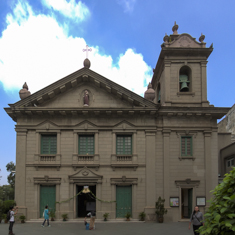
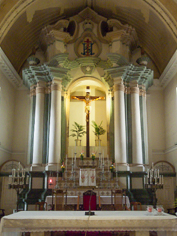
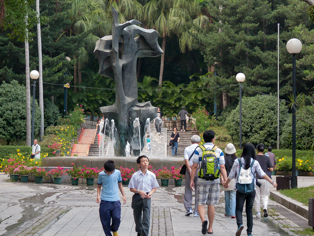
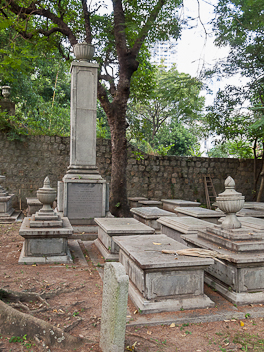
St. Anthony's Church, Casa Garden, & Old Protestant Cemetery: After visiting the museum, we made our way out of the crowds and over to St. Anthony's Church, one of the oldest churches in Macau. First built before 1560, it served as the original headquarters for the Jesuits. It was rebuilt in 1875. Our next stop was at Casa Garden, a lush park and mansion first owned by a Portuguese merchant, Manuel Pereira. At one time the headquarters of the British East India Company and a museum dedicated to Luis De Camoes, a Portuguese poet, it is now the headquarters of the Macau delegation of the Orient Foundation. Adjacent to the garden is Old Protestant Cemetery, the final resting place of several prominent Macau figures of the early to mid-nineteenth century.
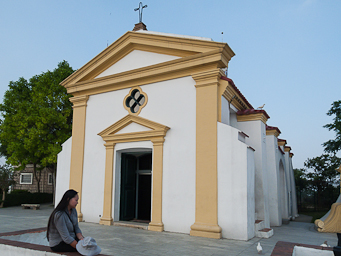
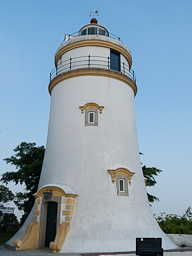
Guia Fortress: Our final stop on the heritage trail required us to ascend Guia Hill. Built in 1622-1638 in response to the Dutch invasion, Guia Fortress sits atop the highest point in Macau, poised to protect the city from foreign invaders. Located within the fortress is Guia Chapel, where frescoes depicting both Western and Chinese themes can be seen, and Guia Lighthouse, the first western style lighthouse in east Asia and still operable today.
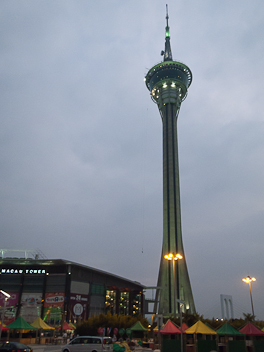
Macau Tower: Having seen all the sites on the Heritage Trail, we headed back to Senado Square, which was now completely packed with people, and to a Pizza Hut for dinner. After eating, we were back on the street making our way to Macau Tower. Completed in 2001, the tower and ground floor complex contains a mall, convention center, restaurants, a movie theater, an observation deck and adventure activities, including a walk on the outer rim of the tower and the second highest bungee jump in the world. Besides entertainment, the tower is also used for telecommunications. We rode the elevator to the observation deck where we got a bird's eye night view of Macau Peninsula, Outer Harbor and Taipa Island.

Kun Iam Statue: From the Macau Tower we walked to the Kun Iam Statue. Modeled after the goddess of mercy, a much revered Chinese Buddhism figure in Macau, the Kun Iam Statue is made of bronze and stands twenty meters tall. At its base is a lotus-shaped ecumenical center, where information on Buddhism, Taoism and Confucianism can be found. It stands on a small, man-made island in the Outer Harbor. The site was closed for refurbishment while we were there.
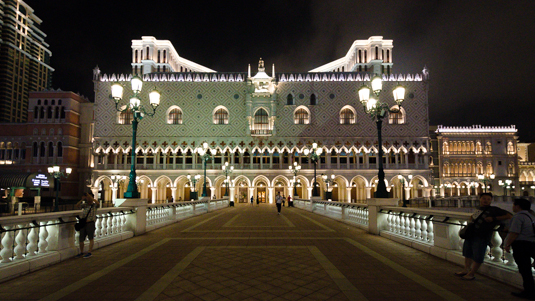

Casinos: Peep was interested in seeing the Sands Casino and the Venetian, so those were our next stops. The Sands was a short walk from the Kun Iam Statue. The Venetian, however, is located on Taipa Island, so we took the free shuttle bus from the Sands to the Venetian. After our short tours of the casinos (neither of us gambled any), we headed back to the condo and called it a night.

